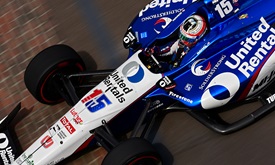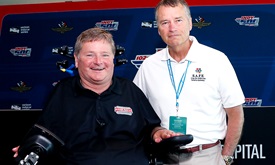Fittipaldi focuses on quick recovery and return to INDYCAR racing
MAY 17, 2018
INDIANAPOLIS – Pietro Fittipaldi is still squirming in a wheelchair, but epitomizing the predictably optimistic perspective of a racer, he’s pushing to get back on a racetrack as soon as possible.
That means in a go-kart next week. And ideally, if his extensive rehabilitation from a left leg fractures progresses smoothly, in an Indy car for the Honda Indy 200 on July 29 at Mid-Ohio Sports Car Course.
“Now it’s my other race,” Fittipaldi said Thursday at Indianapolis Motor Speedway. “Now I’m focused on getting back as fast as possible, you know, getting back to be able to do a good job.”
Fittipaldi, a Dale Coyne Racing rookie, spoke to media as Verizon IndyCar Series cars practiced for the 102nd Indianapolis 500 presented by PennGrade Motor Oil. The 21-year-old grandson of two-time Indy 500 winner and two-time Formula One champion Emerson Fittipaldi was expected to make a much-anticipated IMS debut this month, but a crash May 4 in qualifying for a World Endurance Championship sports car race in Belgium changed that.
Sidelined but refusing to be subtracted from the environment, Brazilian-American Fittipaldi parked his motorhome behind Gasoline Alley, where many of the other drivers reside during the month. That’s also near orthopedic surgeon Dr. Terry Trammell, INDYCAR medical consultant, and support staff, who work just yards away at the IU Health Emergency Medical Center inside the track.
🇧🇷Quero agradecer a todos pelas mensagens que recebi na semana passada. Estou em Indianápolis tratando da minha recuperação. Estarei de volta nas pistas muito em breve! pic.twitter.com/muh0fpNMl6
— Pietro Fittipaldi (@PiFitti) May 15, 2018
Teammate Sebastien Bourdais, who recovered from pelvis and hip fractures suffered in a frightening Indy 500 qualifying crash last year, visited Fittipaldi on Wednesday.
“I was speaking to him for an hour or so,” Fittipaldi said. “He was telling me all about his recovery, his rehab, how he got back in around eight to 10 weeks, something like that. It's obviously very inspiring.”
Coyne said he never doubted four-time Indy car champion Bourdais would bounce back. Bourdais won the season-opening Firestone Grand Prix of St. Petersburg this year and is third in the season points.
Although Fittipaldi has only started one series race — finishing 23rd in the Desert Diamond West Valley Casino Phoenix Grand Prix in April — Coyne sees the same resilient determination in his young driver. The team gave Fittipaldi a radio, so even when confined in the motorhome, he can listen to what’s happening on the track.
“He’s a racer,” Coyne said. “This is the environment he lives in. These are the people that support him. You always learn. You've got to be here to learn. Every day, there's something to learn, whether he's in the pits or just a radio away, people talking to him at night or in the morning. He's going to learn every day. It's great to have him here.”
Fittipaldi looks forward to Grandpa Emerson visiting him at IMS next week. Uncle Max Papis, a series race steward, visited him in the Belgium hospital after the crash and helped coordinate communications and transport plans to Indianapolis with Trammell.
Aggressive rehabilitation involves daily physical therapy. Coyne said one of the most challenging aspects of recovery is preventing an anxious kid from pushing too hard.
🇬🇧Reaction time work today @PitFitTraining 🇧🇷Treino de hoje no @PitFitTraining 🤙🏼 pic.twitter.com/vJwRjU6wHO
— Pietro Fittipaldi (@PiFitti) May 16, 2018
“It’s good to be in the racing environment,” Fittipaldi said, “because it keeps me active.
“I'm already weight-bearing on the left leg, which is quite early, but the doctor has been pushing me quite hard. We're already doing that here. Then getting the mobility back on the right ankle is going to be important, which we already are.”
Rookie Zachary Claman De Melo, who filled in for Fittipaldi and finished 12th in the INDYCAR Grand Prix on the IMS road course on May 12, will drive the No. 19 Paysafe Honda again for Dale Coyne Racing in the Indy 500 on Sunday, May 27.
While he said this setback won’t discourage him from racing elsewhere, Fittipaldi reiterated his No. 1 priority for the remainder of this season. Coyne confirmed that if Fittipaldi returns for Mid-Ohio, he will be in the car through the end of the Verizon IndyCar Series season.
“Doing these last five races are going to be very important,” Fittipaldi said.
Fittipaldi sounded like an experienced veteran when his first question to doctors pertained to how quickly he could return to racing.
“That’s the mentality we have most of the time,” he said.
“They never believe them,” Coyne said of recovery timetable estimates given to drivers. “They want to cut that number in half.”



















